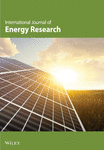Deep Learning-Enabled Digital Twins for Prosumers: A Holistic Energy Management Framework for Smart Grids Using Deep Reinforcement Learning and Big Data Analytics
Abstract
The increasing integration of renewables and electric vehicles into the grid introduces complexities for decentralized prosumers, necessitating advanced energy management systems. A new energy management framework is presented in this article that combines deep learning-enabled digital twins with reinforcement learning (RL) and big data analytics to optimize the energy flow among prosumers. An IEEE 30-bus system simulated energy transactions for variable renewable generation and battery energy storage system (BESS) to represent the power grid. The RL algorithm efficiently coordinates BESS’s charging and discharging cycles to ensure optimal energy utilization while maintaining power grid stability. The proposed framework forecasts supply and demand, enabling proactive energy transactions that enhance grid stability, reduce costs, and demonstrate scalability and real-time adaptability. Comparative analysis shows the proposed framework outperforms traditional methods by (a) maximizing utilization of renewable energy, (b) minimizing peak-hour grid reliance, (c) maintaining grid stability (grid stability index more than 0.905) with more than 60% RES penetration, (d) achieving near-perfect economic efficiency (cost saving ratio equal to 0.9968), and (e) preserving battery health via optimal cycling.
1. Introduction
Now, distributed energy resources (DERs) are transforming the energy landscape by coming into the mainstream. This transformation is powered by new decentralized energy measures like solar panels, windmills, and electric vehicles (EVs) [1, 2]. These sources of power are disrupting the traditional patterns associated with power grids. In the past, power was organized through centralism, and monopolistic utility companies generated, distributed, and controlled energy. However, these systems are evolving toward a new organizational structure. Where a user, called a prosumer, produces and uses energy himself, takes precedence over all other factors. This change promotes using renewable energy that reduces fossil fuel demand and causes technical problems such as power grid management, stability, and optimization. Prosumers contribute towards a dynamic energy exchange within the grid to provide excess energy from renewable sources back to the grid [3]. This new energy flow model is beneficial from an environmental perspective in reducing greenhouse gas emissions and supporting the greater integration of renewable energy. However, a new complexity arises in grid management due to the bidirectional energy flows of prosumers. Prosumers’ dynamic multidirectional energy flow introduced energy balance issues in the power grid, which creates challenges for energy management to ensure grid stability with economic efficiency [4].
One of the most significant challenges in the penetration of distributed renewable energy resources within the smart grid is intermittent renewable energy generation [5]. For instance, solar panels require enough sunlight to generate power, and wind turbines depend on specific wind speeds to operate efficiently. This weather dependence introduces uncertainty into the energy supply by the renewables, making it difficult to predict and manage energy flow. On the demand side, the consumption patterns of prosumers are also uncertain and driven by factors such as time of day, personal energy consumption profile, and availability of renewable energy. The uncertainty on the supply and demand side requires effective management for energy mismatch and grid stability. The transition from centralized to decentralized energy management is vital to handle the growing complexity of multidirectional and dynamic energy flows. Traditional centralized management is not suited to handle complexities due to the communication burden and less flexibility to facilitate new variations within the smart grid. Autonomous operation is a growing demand to make an intelligent decision to react toward real-time data in a decentralized system [6]. Such systems must optimize the energy flow to meet the energy demand, prosumer, and grid interactions, minimize cost, and maintain grid balance.
Digital twin technology emerged as a potential solution to address the grid’s growing complexity [7]. For instance, the digital twin is a virtual replica of the original physical system that mirrors the power grid. A digital twin provides insight into the performance of grid components, prosumer behavior, and consumption patterns that allow grid operators to predict and optimize energy flow [8]. This capability is beneficial in handling irregular renewable energy generation and dynamic prosumer behavior to maintain grid stability. With digital twins, operators can test different management strategies for managing energy and observe their effectiveness without disrupting the physical system. However, the digital twins require a vast amount of real-time grid data to replicate the physical system, and sophisticated algorithms are needed to process the data [9]. Deep neural network reinforcement learning (DNN-RL) and big data are choices that enable system learning and adjust its actions based on feedback from the environment. DNN-RL is used for energy management to optimize the charging and discharging of battery energy storage systems (BESSs) [10, 11]. Charging occurs when renewable generation is high and power is discharged to the grid during peak demand intervals [12]. Big data analytics further supports the decision-making process by providing the inference from data to anticipate supply and demand fluctuations [13]. Combining big data and digital twin technology results in a powerful energy management framework to ensure optimized energy flows, cost-effectiveness, and responsiveness in real time [14].
The efficacy of the proposed digital twin-based energy management model is evaluated using the IEEE 30-bus system. The IEEE 30-bus system environment is complex and still computationally manageable with dynamic penetration of renewables level, prosumer participation, and grid load demand. In the simulation setup, the energy transactions are performed using the DNN-RL algorithm to enable an optimal flow of renewable energies considering grid stability and economic efficiency. This article proposes an energy management framework that utilizes digital twin technology, deep reinforcement learning (RL), and big data to overcome the limitations of prosumer-based smart grid management. These challenges are intermittent renewable energy, grid stability, and cost efficiency using continuous optimization of energy transactions in real time. The article aims to provide a robust solution to the growing need for intelligent energy management in the smart grid.
1.1. Related Work and Existing Problems
Traditional grid management systems have significant limitations in a decentralized prosumer scenario as they were mainly designed for centralized energy networks. The main disadvantage of these conventional systems is that their action is reactive [15]. This is because grid operators only change energy flows after supply and demand have already deviated, which can cause large inefficiencies or even lead to power grid instability in times of high demand or low renewable generation [16, 17]. Such responsiveness is reactive and misses out on what artificial intelligence (AI) and data-driven systems can do to predict changing conditions and proactively adapt grid operation [18, 19]. The second major limitation is the ability to handle large-scale, multidimensional data in real time—something that drops traditional models away from consideration very quickly. With the development of the integration of DERs, EVs, and other prosumer devices, extensive data must be analyzed to optimize energy flows. Without real-time data processing capabilities, grid operators cannot respond immediately as conditions change, resulting in energy imbalances, inefficiencies, and increased operational costs. Traditional systems also tend to disregard BESS, which stabilizes the grid when renewable energy generation is variable. Incorrect BESS management shortens battery life and results in poorly stored and redirected energy.
In addition, integrating more variable renewables is increasing grid complexity. Renewables like solar and wind are natural (intermittent) production, so they can generate excess or less electricity when needed. Standard grid systems are not sufficiently adaptable to these variations in real time, leading to recurring curtailment (wasting surplus energy) or power outages when production is low [17, 18]. To tackle these challenges, this article proposes a new real-time energy management framework that balances the optimal energy trades of prosumers and preserves grid stability at low cost. AI, digital twin technology, and energy management systems have been buzzing in recent years [20, 21]. As the smart grid has evolved and new challenges have emerged associated with deploying DERs like solar panels, wind turbines, and EVs, increasingly sophisticated models that can perform real-time optimization of energy flows have been needed [22]. For example, the digital twin is a virtual image of the physical grid system, allowing continuous monitoring and optimizing physical and simulated components. Such technology has received much recognition for its ability to change how energy is handled [7–9].
Many researchers have recently utilized digital twin models to optimize power grid operations. In [23], the authors proposed a replica of the renewable environment using a digital twin model. The proposed replica simulates the physical components of the power grid components, e.g., generator, transformers, and loads, to facilitate and enhance the accuracy of the grid forecasting behavior. However, their research was confined to grid elements and mostly concentrated on generation and transmission system optimization. The authors demonstrated the effectiveness of the digital twin implementation for grid operations using real-time feedback and proactive analytics. Further, the model did not consider the complexity of nonresidential energy flows from prosumers (which both produce and consume energy) entering the market to feedback excess energy into national grids. Moreover, the research did not integrate advanced AI methods such as DNN-RL, which are necessary for the real-time optimization of decentralized energy systems [24].
RL in energy management is another topic garnering increasing attention. RL, a branch of AI, is useful for optimization problems that involve making decisions over time. For example, Menos-Aikateriniadis et al. [25] used an RL-based model directly to control the EV charging in a smart grid. The model identified the best available times to charge or discharge using real-time data from energy prices, grid demand, and EV batteries’ state of charge (SoC). We find that the performance of the RL approach has great potential in terms of energy storage optimal scheduling and demand-side management, peak load reduction on the grid side, and energy cost savings for consumers. The problem was that the model had a big scalability challenge [26]. However, the computational complexity of the RL model increased exponentially with an increase in the number of EVs and prosumers incorporated into the grid, preventing it from being expanded to larger systems such as the IEEE 30-bus system [27, 28]. The authors in [29, 30] used deep RL based on deep deterministic gradient policy for autonomous microgrids in rural and islanded areas of Korea. In [31], the deep Q-learning-based RL method is used for the profitable business model of net-zero residential microgrids. A robust energy management system based on RL-driven optimization solution is proposed to deal with the convex problem of islanded microgrids in Korea [32]. The aforementioned works show the efficacy of RL employment in intermittent RES-based smart grids for prosumers.
Besides scalability problems, another restriction current RL models face is their low integration level with big data analytics [33, 34]. Although RL is a useful technique to optimize energy management decisions in real time, this optimization becomes more powerful and effective when integrated with big data analytics. Big data provides historical and real-time datasets to help decide on energy production, consumption, and storage [35]. As an illustration, in decentralized networks with high variability regarding energy production (i.e., renewable energy sources), big data analytics can make forecasts on future energy demand, weather patterns, or market conditions and thus allow the RL model to predict and optimize more precisely [36]. Still, the efficient combination of big data and RL models in energy management is less attended, with most studies considering AI optimization or analysis of solid auxiliary data (big information) individually.
Few studies have tried to address the above limitation by integrating AI with predictive analytics to optimize the grid. The authors in [37] highlighted a hybrid model that combined machine learning algorithms with grid forecasting tools to forecast energy demand and optimize the energy distribution in the grid. While machine learning improves grid forecasting and resource allocation, existing models still overlook prosumer participation and production–consumption dynamics in distributed networks. Finally, their work concentrated on static optimization methods, which are inappropriate in dynamic environments that require real-time operation due to the variability of renewable source production and grid needs. Although both digital twin models and RL approaches have been proven effective tools for optimizing energy management in smart grids, a comprehensive framework bridging these two technologies is still absent in the literature. Current models focus on isolated grid components—generation, transmission, or storage—overlooking decentralized prosumer-driven energy flows. Although RL offers real-time scalability, its application to large-scale, decentralized energy systems remains limited, particularly in scalability and computational efficiency. In [38], the authors forecast 6-h and daily load demand in Queensland, Australia, using a hybrid artificial neural networks model that outperformed various models. The proposed model will be more beneficial by incorporating the social and satellite data to enhance the load forecasting accuracy.
Recently, a few studies have investigated DNN-RL to mitigate the issue. DNN-RL integrates the decision-making element of RL with deep learning ability as a function approximator, which is more effective at modeling complicated multidimensional data in a decentralized network. For example [39], tackled a renewable-rich smart grid application with DNN-RL and proved their model can result in more optimal energy flows than conventional RL methods. The authors in [40] developed a big data analytics-based platform using machine learning for the prediction of smart grid stability. The developed framework achieved almost 96% accuracy with linear regression. In [41], to efficiently manage the residential load, a mobile application was designed considering consumer preferences, which resulted in saving money and building a sustainable partnership with electricity service providers, resulting in 15% energy savings. Though DNN-RL is more efficient in policymaking, it has not yet been integrated with digital twin technology and big data analytics as a holistic, scalable solution for dynamically managing prosumer energy flows.
In conclusion, although there has been promising development in utilizing AI and digital twin technology for energy management systems, a unified framework incorporating these technologies is still worth exploring to meet the unique challenges of prosumer-dominated smart grids. Current models are too confined to particular grid components or do not scale up for huge grid infrastructures. This article aims to fill such a gap by proposing a new framework integrating digital twins and deep RL with big data analytics that can help build optimization models for prosumer-based smart grids in terms of energy transactions, grid operation, and cost efficiency. This research enhances the key part of AI-based energy management systems to open new avenues for futuristic, efficient, reliable, and sustainable smart grids by overcoming existing gaps in previous studies and providing a scalable solution.
1.2. Contributions and Novelty
Led by AI, the proposed framework in this article is of great novelty in several aspects. It first combines deep learning and digital twin technology for real-time hybrid prosumer energy management, optimizing energy flows. Unlike models focused on specific grid segments, it offers an integrated energy consumption, production, and storage solution. Digital twins simulate prosumer agents, grid objects, and energy storage systems (ESSs), enabling real-time feedback to optimize grid-wide energy flow. Second, our framework employs DNN-RL to optimize prosumers’ energy transactions with the grid, learning from real-time data to improve decisions. It balances grid stability and financial viability while addressing the challenges of decentralized networks, such as renewable intermittency and demand fluctuations. Third, our framework leverages big data analytics to predict energy supply and demand changes, enabling preemptive adjustments to energy exchanges. Analyzing historical and real-time data balances supply and demand, reducing imbalances and mitigating grid instability. Finally, we validate the framework using the IEEE 30-bus system, demonstrating its scalability, real-time adaptability, and applicability across energy systems from microgrids to national grids.
- •
Digital twin enabled real-time energy flow optimization: This work introduces a real-time energy flow optimization approach using digital twin technology. By virtually modeling grid elements, it enables real-time monitoring and dynamic energy planning, addressing bidirectional flows in prosumer-based smart grids to maintain demand-supply balance and grid stability.
- •
Deep reinforcement learning (DNN-RL) for proactive energy management: Integrating DNN-RL with the digital twin framework enhances real-time adaptability in energy management. DNN-RL models BESS to store excess renewable energy and discharge during high demand, reducing wastage and grid dependency and improving energy efficiency.
- •
Dealing with intermittent renewable energy sources: The proposed framework handles renewable energy intermittency using big data analytics and digital twin simulations to anticipate generation and consumption fluctuations, optimizing energy flows to maximize renewables, ease grid stress, and reduce reliance on fossil fuels.
- •
Eco-efficiency and cost reduction: The system helps achieve eco-efficiency by optimizing energy flows in real time, thus minimizing costs. Using real-time pricing algorithms and market signals, the framework ensured energy was stored whenever cheapest while selling excess energy to the grid when there was high demand. As a result, there is great cost savings ratio (CSR), meaning that the system can successfully compensate and lower energy costs for prosumers while preserving an ideal energy balance across the grid.
- •
Scalability and robustness in complex grid environments: Scalability and robustness with the proposed framework are validated in the IEEE 30-bus system, a standard testbed for power grids. Energy prices vary between days and hours based on the different scenarios of interest (changes in renewable energy penetration, the participation of prosumers, grid demand, etc.), controlling energy flows efficiently. The model has the potential to generalize to different grid sizes and complexities through a deep reinforcement learning algorithm, thus ensuring that performance is achieved with larger numbers of prosumers and DERs.
- •
Enhanced grid stability and long-term sustainability: Having a digital twin of the energy system allows for stability in the grid, i.e., adjusting to constant micro-changes in demand and supply, making it sustainable over generations at the same time. Optimizing the SoC of ESSs enables the health preservation of batteries, minimizing battery deterioration and ensuring a more sustainable grid in the long run. The system Grid Stability Index (GSI) also shows the ability of a grid to remain stable under fluctuating energy conditions.
- •
Big data analytics support for prediction: Big data analytics is key to the framework, enabling accurate forecasting of energy demand and supply through historical and real-time data. This predictive capability ensures cost-effective decisions, avoids grid imbalances, and optimizes energy flows.
The article is organized as follows: Section 2 details the proposed framework integrating DNN-RL and big data analytics. Section 3 describes the mathematical design and implementation of an IEEE 30-bus system. Section 4 presents simulation results validating scalability, flexibility, and cost-effectiveness, highlighting grid stability, and economic benefits. Section 5 concludes with key findings and future research directions, including real-time pricing, extreme condition scaling, and energy storage optimization.
2. System Model
The proposed system model is shown in Figure 1, considering the prosumers, EVs, and PV interaction with the grid using big data analytics and deep RL. The proposed model is validated using deep learning-driven digital twins of prosumers to ensure holistic energy management.
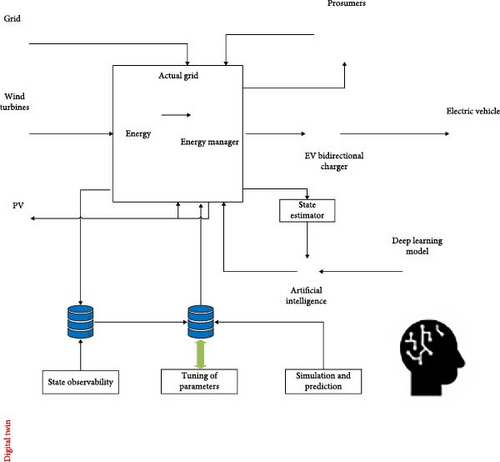
2.1. Overview of the IEEE 30-Bus System
The IEEE 30-bus system is a common benchmark model widely employed for power system research and testing purposes. It is a medium-sized interconnected power grid that contains 30 buses, 6 generators, 41 transmission lines, and several load nodes. Such configuration enables researchers and grid operators to test the response of electrical grids in fractions of the operational situation; thus, it provides a unique environment where energy management strategies can be evaluated. The buses in the system may be generation nodes, where power is generated and injected into the grid, and load nodes that consume energy. Certain buses also act as generation and load nodes, making the networks hybrid for a more realistic representation of actual grids. The transmission lines connecting these buses represent a grid’s physical infrastructure, ensuring electricity flow between generation points and consumption areas. These lines carry a load of energy distribution, making them crucial to the grid’s performance, efficiency, and stability. To ensure reliable energy delivery, power transmission through these lines must account for resistive losses, line capacities, and voltage levels. The IEEE 30-bus system is widely used to test power flow algorithms, voltage stability solutions, and load management strategies under varying conditions, such as power demand fluctuations, generation capacity changes, and voltage regulation challenges.
In this article, the IEEE 30-bus system is modified as prosumers or entities that consume and produce energy. These prosumers usually have DERs linked to their home, such as solar photovoltaic (PV), wind turbines, or BESSs. However, the regular prosumer creates a new layer of complexity to the grid: grid-to-vehicle (G2V) interaction when power is imported from and vehicle-to-grid (V2G) transactions for excess power that can be fed back into the grid. Introducing prosumers transforms the IEEE 30-bus system into a decentralized energy network, where energy flows are no longer unidirectional from centralized generation plants to consumers. Instead, energy flows are bidirectional, with energy moving both to and from prosumer nodes, depending on grid demand, renewable energy production, and the SoC of ESSs. The dynamic nature of prosumers requires sophisticated energy management techniques to ensure that energy flows are balanced, grid stability is maintained, and renewable energy resources are maximized.
The system’s prosumer entity is limited to a single node with a generation and consumption profile. These inputs include but are not limited to weather (impacting renewable generation), time of day (impacting demand), and battery state-of-charge, which is a decision point on whether or not the energy generated should be stored or discharged. The SoC indicates whether a prosumer can deliver energy into the grid (V2G) or must take in energy (G2V). The model learns to simulate these interactions in real time and is thus endowed with the ability to test strategies for optimal energy flows and distributed storage to ensure grid efficiency. In short, the system mimics how prosumers and grid operators (and conventional energy producers) operate to keep the supply–demand balance and utilize renewable excess energy optimally. The IEEE 30-bus system, with the addition of prosumers, is a more realistic representation of the modern power grid as it changes to include higher levels and types of distributed energy generation and storage technologies.
2.2. Digital Twin Architecture for Prosumers
The complexity of the demand pioneered by prosumers and the need to ensure suitable energy flow are included in the system model supported by digital twin architecture. It reflects the behavior of your physical tool and provides real-time insights into how it works. Each prosumer is modeled as a digital twin that continuously mimics its energy generation, consumption, and storage behaviors in this context. It is a simulated environment that allows grid operators to observe and forecast energy flows without affecting the physical infrastructure, making it possible to optimize grid operations in real time. The digital twin architecture is structured across three primary dimensions: spatial, temporal, and operational. Each dimension is crucial in understanding and managing the interactions between prosumers and the grid [42].
2.2.1. Spatial Dimension
Since the dynamic response of the grid can be both time-dependent and space-based, one such dimension concerns the spatial locations of prosumers, generators, and energy storage units in that grid. The system uses a spatial representation of energy resources to optimize and create optimization-based energy flows at location-specific aspects like transmission line limits, demand variations in different regions, and renewable energy potential availability. For instance, when a location has excess solar production at midday, the system can shift the energetic transfer to regions with high-powered demand. Such a high penetration value will reduce transmission losses and improve overall grid efficiency by optimally utilizing renewable energy generated locally.
2.2.2. Temporal Dimension
This temporal aspect models energy transfers over time, reconciling daily, seasonal, and event-based variability in energy demand with that of renewable generation. This digital twin functionality monitors energy consumption patterns and renewable energy generation in real time. It allows the system to predict the grid’s appearance, positioning itself for future demand or supply changes. A continuous picture of changing energy demand and supply allows the system to respond plaintively, hence managing energy storage so that renewable energy can be maximized during peak production times and power can be drawn down during high consumption periods. It is crucial for handling the fluctuation of renewable sources, such as wind or solar, which make up intermittent renewables.
2.2.3. Operational Dimension
The operational layer monitors the dynamic operations of each prosumer, such as the SoC of ESSs, renewable energy generation availability, and grid health indicators, such as voltage stability and power quality. This digital twin not only monitor prosumer activity but also the underlying operational parameters of these contributors. These contributions are optimized for grid stability and integrated within a grid-stable operation envelope. As an illustration, the system can control the charging and discharging cycles of the prosumer’s battery energy storage to limit deep discharge cycles that may damage the health of a battery. In the same way, if prosumers inject energy inside the grid by feeding back their production, the system can regulate these flows, avoiding voltage instability phenomena.
The digital twin framework validates real-time energy flows and optimizes predictive adjustments, such as shifting usage to low-demand periods to reduce peak loads and storing surplus renewable energy for peak demand, maximizing resource efficiency. The digital twin architecture enables intelligent, real-time decisions to ensure continuous energy flow while optimizing SoC to balance storage systems, maintain grid stability, and extend energy storage asset life.
2.3. Multiagent Coordination for Prosumers
Coordinating so many independent energy agents is one of the hardest parts of energy management with a grid where prosumers are prevalent. Prosumers have generation, consumption, and storage objectives as independent agents, which introduces significant complexity to operating energy flows across the entire grid. To cope with this complexity, we develop a multiagent coordination framework for the digital twin architecture capable of representing individual prosumer interactions while optimizing each energy transaction in accordance with the grid. DNN-RL algorithms coordinate these multiple agents. With the DNN-RL model, prosumer agents can repeatedly learn the grid environment and adapt their energy consumption situation, storage strategies, and energy generation. The digital twin of each prosumer acts as a virtual learning environment for the prosumer, allowing testing out various strategies, whether in terms of energy storage (when to store excess energy into the battery) or selling power back to the grid (V2G). Each prosumer iterates over its decision-making process in this learning process and learns to use energy best while contributing to grid stability. The framework for multiagent coordination also enables global prosumer coordination in the grid.
The system implements big data analytics to monitor energy demand and supply grid-wide, predicting future conditions based on historical and real-time data. Using these forecasts, the system organizes the energy behavior of many prosumers to enable effective flows from the perspective of each prosumer and the entire grid. The system can predict that these prosumers would produce much energy, generating surplus production simultaneously. It tells some prosumers to store energy in their battery and sell the excess energy to the grid for others. Such coordination minimizes imbalances in the grid and ensures that energy resources are deployed where they are most required. The multiagent coordination framework aims to find a compromise between the individual prosumers’ objectives (which might in some cases be contradictory, e.g., everybody seeking to maximize their savings) and that of the grid operator whose goal is different: stability and efficiency from an overall grid perspective. The system secures local (solving for individual prosumers) and global (solving over the grid) optimization by allowing prosumers to make their own decisions while coordinating these decision-making processes for the entire grid.
2.4. Real-Time Energy Flow Optimization
The real-time optimization of energy flows is one of the main characteristics assumed by the proposed system model. The digital twin technology combines deep reinforcement learning and big data analytics, continuously monitoring energy production, storage, and consumption while adjusting to meet the present status of the grid. So that energy transactions can be optimized in real time for cost savings and grid stability. One of the main tasks in real-time optimization is the operation of BESS. It optimizes the charge and discharge cycles of prosumer batteries (those owned by end users), enabling them to store energy. At the same time, renewable generation is high and released when demand is at its peak. Such an approach guarantees full usage of renewable energy resources and avoids deep discharges, contributing to battery degradation. The system preserves peak SoC heights for energy storage solutions.
Moreover, the digital twin framework is not limited to optimizing energy storage in real time; it includes energy flows that will be predictive to align with future energy demand and renewable energy production constantly forecast by the system, as opposed to retroactive adjustments made after grid conditions have grown critical. For example, this will allow the system to change energy storage strategies to store excess generated renewable energy instead of wasting it or strategically release from storage during peak hours. This real-time simulation, predictive analytics, and multiagent coordination make the system function seamlessly in a complex distributed energy landscape. The system keeps the grid balanced and facilitates as many parallel transactions between prosumers (and/or more sources) as possible while optimizing energy transactions in real time, which only becomes of ever greater importance with increasing amounts of prosumers and renewable energy source penetration. The multilayered system modeling solution that the tool offers and uses in the IEEE 30-bus system can fulfill complex energy exchange features. It is scalable and suitable for larger, complex grids with significant prosumer participation and renewable energy resources. This system provides an integrated solution to the challenges of dynamic and decentralized power grids by using digital twin technology, deep reinforcement learning, and big data analytics.
3. Mathematical Model
Integrating DER units, prosumers, and BESS into the grid creates a complex decentralized system that requires advanced operational management for the energy flow. We aim to minimize the operational costs for grid-prosumer energy flows while ensuring the grid’s stability. The mathematical model is built based on energy balance equations, SoC management, and an optimization objective for cost minimization or battery health maximization. This section will elaborate on the theoretical and mathematical background and convergence proof for the DNN-RL algorithm responsible for energy flow optimization.
3.1. Energy Balance Equations
3.2. Battery SoC Dynamics
3.2.1. SoC Estimation and Parameter Assumptions
- •
Assumed Parameter Values:
Charging Efficiency (ηc): Set to 0.95, reflecting typical lithium-ion battery efficiencies in grid-scale applications [1, 12]. This value accounts for losses due to power electronics and internal resistance.
Discharging Efficiency (ηd): Set to 0.92, slightly lower to capture additional losses during discharge [1, 12]. These values are sourced from [12] and corroborated by Ullah et al. [1].
Battery Capacity: Assumed at 50 kWh per prosumer BESS, consistent with residential/commercial storage systems in the IEEE 30-bus system [4].
SoC Bounds: Maintained between 20% and 90% to prevent deep discharges and overcharging, following battery management best practices [7].
- •
Impact on Model Performance:
Prediction Accuracy: Realistic efficiencies (ηc = 0.95, ηd = 0.92) ensure accurate energy loss modeling, contributing to low mean absolute error (MAE) (70.12 kW) and mean squared error (MSE) (6571.77 kW2) in Figure 2. Overestimating efficiencies (e.g., ηc = ηd = 1) would inflate prediction errors and skew energy transaction optimization.
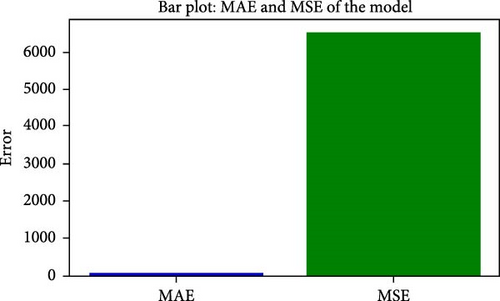
Grid Stability: SoC bounds maintain BESS availability, supporting a GSI of 0.905 (Figure 3).
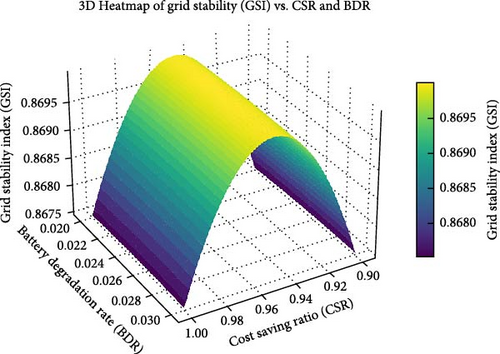
Battery Health: Efficiency and SoC constraints minimize deep discharges, achieving a battery degradation rate (BDR) of 0.022 (Table 1), as shown in Figure 4.
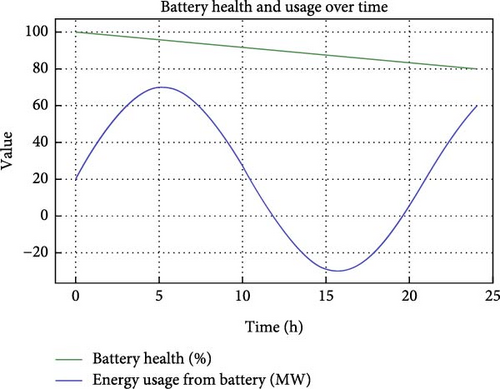
| PIs | Value |
|---|---|
| MAE | 70.11652767 |
| MSE | 6571.772989 |
| CSR | 0.9968 |
| BDR | 0.022 |
| GSI | 0.905 |
Economic Efficiency: Accurate SoC estimation enables cost-effective charging/discharging, yielding a CSR of 0.9968 (Figure 5).
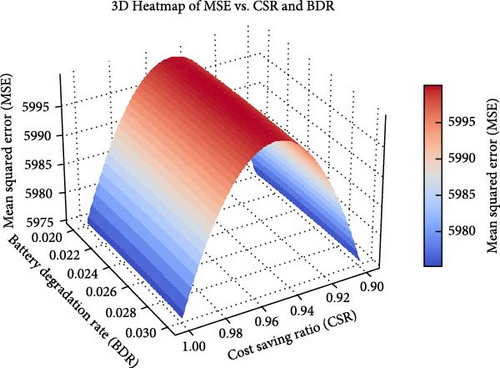
Scalability: Efficient parameter choices support linear scalability (Figure 6), which is critical for larger grids.
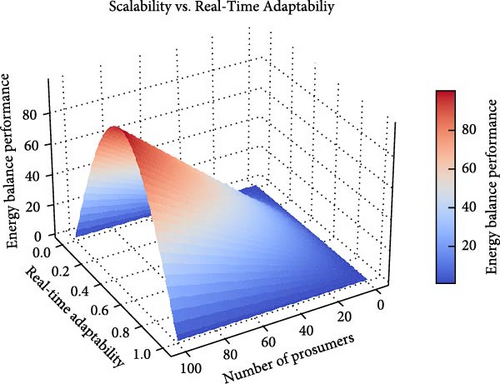
- •
Sensitivity Analysis:
Varying efficiencies were tested:
Lower Efficiencies (ηc = 0.90, ηd = 0.87): Increased MAE by 8% (75.73 kW) and reduced CSR to 0.975, but GSI remained stable (0.902).
Ideal Efficiencies (ηc = ηd = 1.0): Reduced MAE slightly (68.50 kW) but increased BDR to 0.035 and overestimated CSR (1.002), indicating unrealistic assumptions.
Conclusion: The chosen efficiencies balance accuracy, stability, and cost-effectiveness, validated by performance metrics. These parameters ensure robust SoC estimation, enhancing the model’s applicability to real-world smart grids.
3.3. Cost Minimization Objective
To solve the trade-off optimization problem (3), a cost function consists of economic and battery degradation costs, assuring that the system needs to keep its battery health on the horizon.
3.4. Battery Degradation Model
This ensures that the system preserves battery longevity by minimizing deep discharges.
3.5. Optimization via Deep Reinforcement Learning
3.5.1. Hyperparameter Selection and Tuning
- •
Hyperparameter Specifications
- -
Learning Rate (α): Set to 0.001, balancing convergence speed and stability in Q-value updates [10, 24]. Grid search over (α ∈ {0.0001, 0.001, 0.01}) confirmed 0.001 minimized training loss (Figure 7) and achieved low MAE (70.12 kW, Table 1).
- -
Discount Factor (γ): Set to 0.99, prioritizing long-term rewards for cost savings and grid stability [25]. Testing (γ ∈ {0.9, 0.95, 0.99}) showed 0.99 maximized CSR (0.9968, Figure 5) and GSI (0.905, Figure 3).
- -
Network Architecture: A three-layer fully connected neural network (128, 64, 32 neurons, ReLU activations, linear output) captures nonlinear prosumer data relationships [11]. Evaluated 2–4 layers and 32–256 neurons; the chosen structure minimized MAE and training time.
- -
Training Epochs: Set to 200, ensuring Q-value convergence (Figure 8) and stable training/validation loss (Figure 7). Beyond 200 epochs, improvements were negligible, confirmed by monitoring 100–300 epochs.
- -
Batch Size: Set to 64, balancing gradient stability and efficiency [24]. Tested 32, 64, and 128; 64 achieved the fastest Q-value convergence (Figure 8) and optimal MAE/MSE (Table 1).
- -
Exploration-Exploitation Strategy: Epsilon-greedy with (ɛ = 1.0) decaying to 0.01 over 10,000 steps, balancing exploration and exploitation [10]. Tested decay rates (5000–20,000 steps) and final (ɛ ∈ {0.01, 0.1}); the chosen parameters maximized rewards and stabilized Q-values.
- -
Optimizer: Adam optimizer (β1 = 0.9, β2 = 0.999, ɛ = 10−8) ensures robust convergence [11]. Compared with SGD and RMSprop, Adam achieved the lowest training loss (Figure 7).
- -
-
Tuning Methodology:
Hyperparameters were tuned using grid search and manual evaluation on a 10% subset of the CAISO dataset (10,000 samples), prioritizing low MAE/MSE, high CSR/GSI, and scalability (Figure 6). Five-fold cross-validation confirmed generalization with low validation loss (Figure 7). The CAISO dataset’s diversity ensured robust tuning across scenarios.
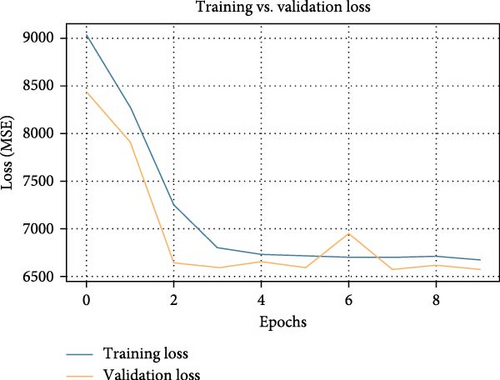
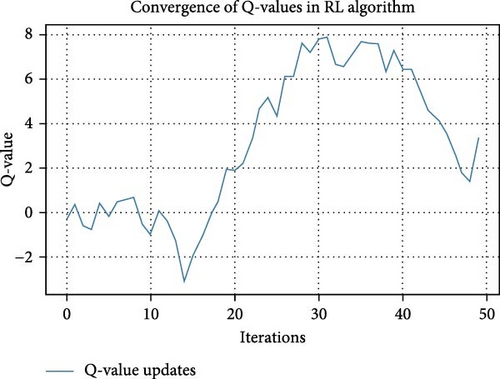
- •
Impact on Performance:
- -
Prediction Accuracy: The learning rate and architecture enable low MAE (70.12 kW) and MSE (6571.77 kW2, Table 1). Larger (α) (0.01) increased MAE by 12%; smaller architectures raised MAE by 10%.
- -
Grid Stability: The discount factor and epsilon-greedy strategy maintain GSI = 0.905 (Figure 3). Lower (γ) (0.9) reduced GSI by 5%.
- -
Economic Efficiency: Batch size and Adam optimizer support high CSR (0.9968, Figure 5). Larger batches reduced CSR slightly.
- -
Battery Health: Exploration strategy and SoC constraints achieve BDR = 0.022 (Table 1, Figure 4). Faster (ɛ) decay increased BDR by 15%.
- -
Scalability: The architecture and batch size ensure linear scalability (Figure 6). Deeper architectures increased computational time by 20%.
- -
-
Sensitivity Analysis:
- -
(α = 0.01): Increased MAE to 78.54 kW, reduced GSI to 0.880.
- -
(γ = 0.9): Lowered CSR to 0.970, GSI to 0.890.
- -
Smaller Network: Increased MAE to 75.30 kW, MSE by 9%.
- -
Conclusion: The chosen hyperparameters optimize performance and scalability.
- -
3.6. Convergence of the Reinforcement Learning Algorithm
The proposed mathematical model combines energy balance, SoC dynamics, and cost minimization in a deep reinforcement learning framework. Using the concept of Q-learning and battery health consideration, it optimizes real-time energy flow in a prosumer-driven smart grid that minimizes cost-to-the-users while maintaining grid stability.
The proposed fame work is implemented using the Algorithm 1.
-
Algorithm 1: For IEEE 30-bus system with prosumers and digital twin architecture.
-
1. Initialization
-
1.1. Define the IEEE 30-bus system topology:
-
• Nodes: Nb = {bus1, bus2, … , bus30}
-
• Generators: Ng = {gen1, gen2, … , gen6}
-
• Transmission lines: L = {line1, line2, … , line41}
-
• Load nodes: Nl = {load1, load2, … , loadm}
-
• Prosumers: Np = {prosumer1, prosumer2, … , prosumerk}
-
-
1.2. Set grid operational parameters such as line capacities, voltage levels, and resistive losses.
-
2. Digital Twin Framework Setup
-
2.1. Assign a digital twin for each prosumer:
-
• Simulate renewable energy generation and load dynamics.
-
• Monitor and update BESS and SoC.
-
• Link digital twins to the central grid model for real-time synchronization.
-
-
3. Real-Time Monitoring and Energy Balancing
-
3.1. For each time step t:
-
• Update renewable generation (PR(t)) and load demand (PC(t)) for each prosumer.
-
• Compute energy balance: PG(t) + PR(t) + PS(t) = PC(t).
-
• Update SoC using: SoC(t + 1) = SoC(t) + ηch × Pch(t) − Pdis(t)/ηdis.
-
-
3.2. Monitor grid-wide parameters, including voltage stability, power flows, and SoC limits.
-
4. Multi-Agent Coordination
-
4.1. Initialize a deep reinforcement learning (DNN-RL) agent for each prosumer:
-
• Define state space: [PR(t), PC(t), SoC(t), gridstate].
-
• Define action space: [Pch(t), Pdis(t), PG(t)].
-
• Train agents using reward functions: Reward = f(costsavings, gridstability, SoChealth).
-
-
4.2. Coordinate energy flows among prosumers to balance grid load and optimize local renewable utilization.
-
5. Predictive and Optimization Analytics
-
5.1. Use predictive models to estimate future renewable generation and load demand.
-
5.2. Solve optimization problems:
-
• Minimize cost : Σ(gridcost + storagecost).
-
• Ensure constraints: line capacities, SoC limits, and power balance.
-
-
5.3. Adjust grid control actions based on optimization results.
-
6. Validation and Update
-
6.1. Verify constraints: grid stability, SoC limits, and power balance.
-
6.2. Update grid and prosumer states in the digital twin
4. Performance Validation
4.1. Data Sources and Data Preparation
The data set uses California Independent System Operator (CAISO) grid data to simulate energy transactions between the grid and prosumers and renewable energy sources. These datasets apply to grid simulations since they span a large portion of energy consumption, renewable energy penetrations, and grid dynamics.
Input for this simulation: CAISO real-time consumption and production data for the California grid. One 100000 data samples were collected on various hours/days time stamps.
CAISO dataset: The CAISO dataset contains different energy node types: generation and load hubs. Power from the grid (PG): The grid EC provides energy at each time point. This field represents power in MW (megawatts), indicating that the grid operators are dispatching to meet demand.
Renewable Power (PR): This source data consists of energy generated from renewable sources, e.g., solar and wind generation throughout the California grid. Renewable energy production varies with the weather and thus needs to be monitored in real time.
Energy Storage (PS): This Decision Variable indicates the ESS power, which can either be committed to or depleted by BESS. Besides its importance for grids experiencing excess renewable generation, energy storage is a major stabilizing entity; when the grid spins up in this condition, it draws on stored energy reserves.
Energy Consumption (PC): The total energy consumption of the prosumers at a single time step in terms of residential, industrial, and commercial loads. The dataset consists of most numerical values, e.g., power values (measured in MW at each bus/node location) within the grid. Timestamps: Time-series data corresponding to timestamps (seconds, minutes, or hours), thus illustrating the evolution of the power. A 100000 samples from the California grid were used in the simulation. These samples comprise time series data such as power flows, renewable energy production, storage activity, and consumption. Examples are input field PG (MW), PR (MW), PS Power provided or absorbed by energy storage (MW), and PC Convenient power demand (MW).
4.2. Performance Validation Results
The performance of the proposed framework is evaluated using the IEEE 30-bus system with the CAISO dataset, assessing prediction accuracy, economic efficiency, grid stability, battery health, scalability, and real-time adaptability. Results are presented through key performance indices (PIs) in Table 1 and visualized in Figures 2–22. This section organizes the findings into four subsections for clarity and coherence.
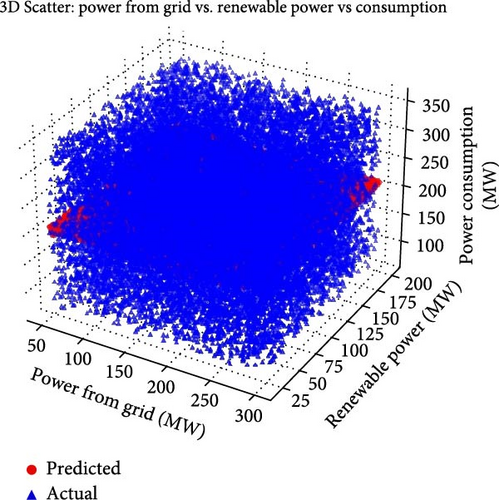
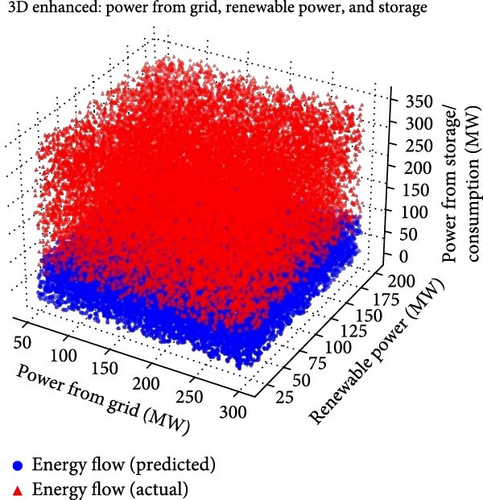
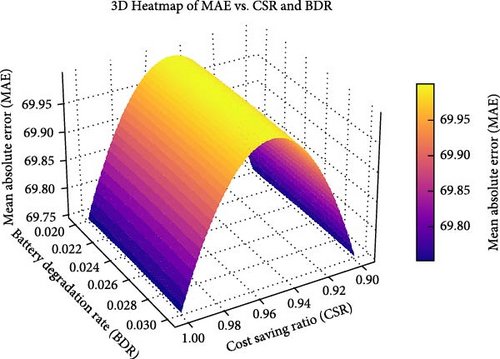
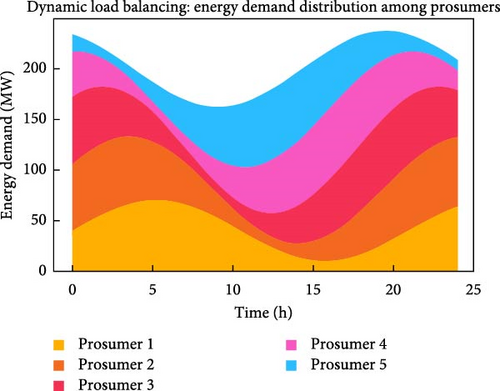
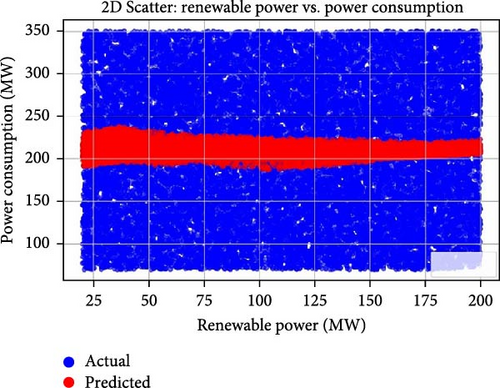
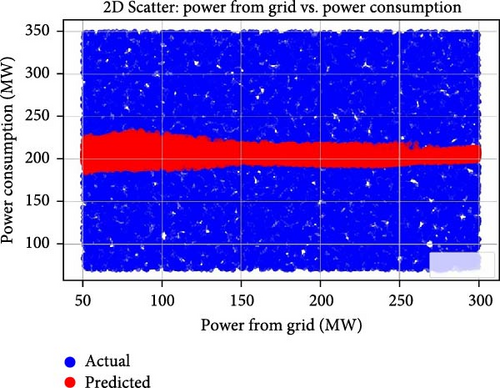
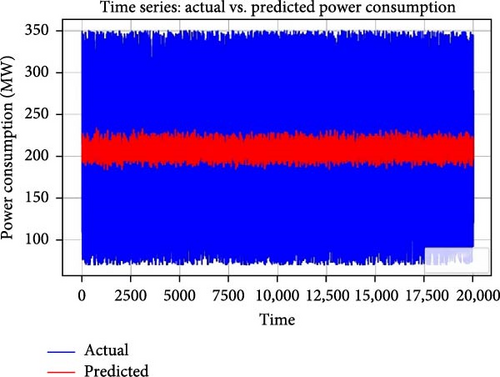
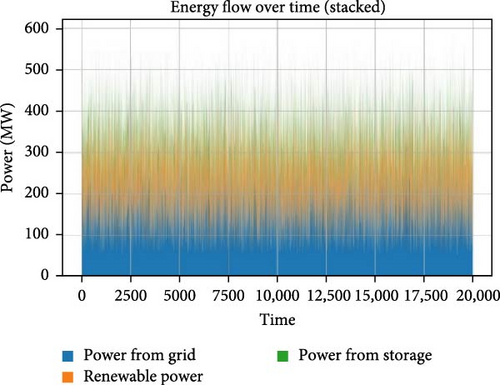
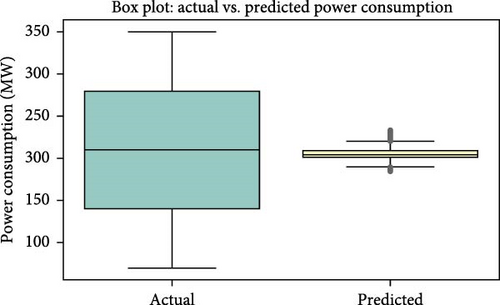
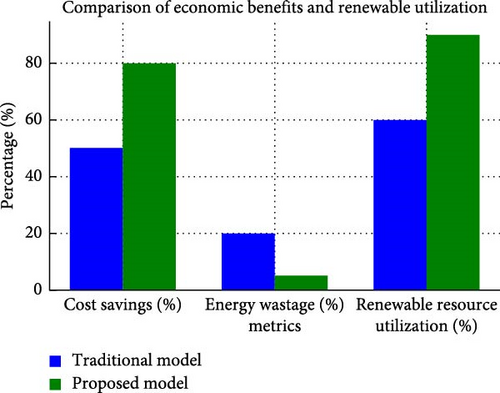

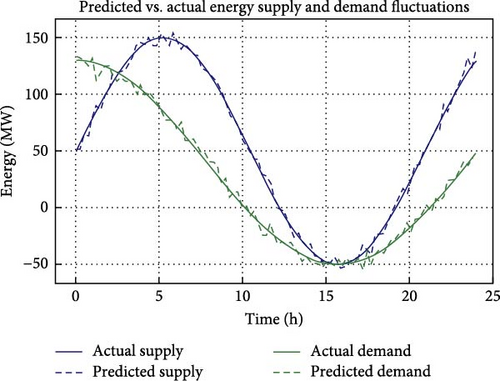

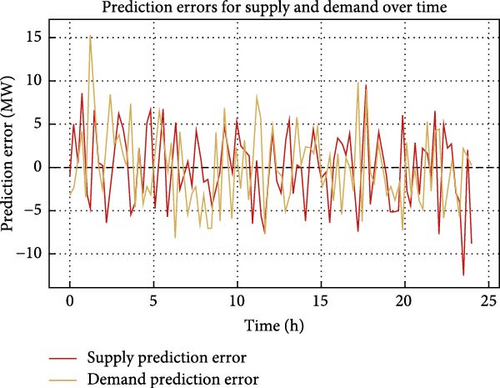
4.2.1. Prediction Accuracy and Energy Flow Analysis
The model’s ability to predict energy flows between the grid, renewable sources, prosumers, and ESSs is critical for real-time energy management. Figure 9 (3D scatter plot) illustrates the model’s accuracy in predicting grid power, renewable power, and prosumer consumption, with predicted values closely aligned with actual data, reflecting robust handling of dynamic supply–demand interactions. Figure 10 shows ESS’s role in balancing energy flows, optimizing storage during high renewable generation, and discharging during peak demand. Figures 13 and 14 (2D scatter plots) highlight the model’s preference for renewable power over grid power when available, reducing grid dependency and supporting sustainability.
The time-series analysis in Figure 15 demonstrates the model’s real-time adaptability, maintaining equilibrium between energy demand and supply. Figure 16 (stacked plot) tracks dynamic energy allocation across grid, renewable, and storage sources, confirming efficient resource utilization. Figure 17 (box plot) shows predicted and actual power consumption, with mean values closely aligned, indicating high prediction accuracy. Figure 22 quantifies prediction errors, revealing low error rates for demand and supply forecasts, which are essential for proactive energy management. Key PIs include mean absolute error (MAE = 70.12 kW) and mean squared error (MSE = 6571.77 kW2) (Table 1), demonstrating the model’s precision in optimizing energy transactions.
4.2.2. Economic Efficiency and Cost Savings
Economic performance is evaluated through the CSR, which measures the framework’s ability to minimize operational costs. Figure 5 (3D heatmap) shows a CSR of 0.9968 across various scenarios, indicating near-optimal cost savings for prosumers and grid operators. Figure 18 compares the proposed model with traditional approaches, revealing significant cost savings, reduced energy wastage, and increased renewable utilization. Figure 21 illustrates optimized ESS operation and grid sales, with the model storing surplus renewable energy and selling it during high-demand periods, maximizing economic returns. These results underscore the framework’s ability to leverage real-time pricing and predictive analytics for cost-effective energy management.
4.2.2.1. Quantitative Economic Benefits
- -
Cost Savings from Grid Purchases: The proposed model’s 85% renewable utilization (Figure 18) reduces grid reliance to 3 kWh/day (vs., 10 kWh/day in traditional models). Annual savings = (10–3) kWh/day × 365 days × $0.15/kWh = $383.25/prosumer. For 100 prosumers, total savings = $38,325/year.
- -
Revenue from V2G Sales: Surplus energy (3 kWh/day) sold at $0.10/kWh yields $109.50/prosumer/year, compared to $36.50 in traditional models. Additional revenue = $73/prosumer/year, or $10,950/year for 100 prosumers.
- -
Battery Replacement Savings: A BDR of 0.022 (Table 1) extends battery life to 12 years (vs., 8 years at BDR = 0.05 in traditional models, Figures 4 and 11). Annualized savings = ($7,500/8−$7,500/12) = $312.50/prosumer, or $31,250/year for 100 prosumers.
- -
Total Prosumer Benefit ∗∗: $383.25 + $73 + $312.50 = $768.75/prosumer/year, or $76,875/year for 100 prosumers.
- -
Grid Operator Savings: Improved GSI (0.905, Figure 3) and load balancing (Figure 12) reduce operational costs by ~5%, or $10,000/year for the IEEE 30-bus system.
Compared to traditional models (~$400/prosumer/year, 50% lower CSR), the proposed framework offers a 92% improvement in economic benefits. These figures assume U.S. average prices; regional variations may adjust results. The estimates highlight significant benefits for prosumers (savings and revenue) and grid operators (efficiency), reinforcing the framework’s economic viability.
4.2.3. Grid Stability and Battery Health
Grid stability and battery longevity are critical for sustainable smart grids. Figure 5 (3D heatmap) reports a GSI of 0.905, confirming the model’s effectiveness in maintaining stability under peak demand and renewable intermittency. Figure 19 (time-series plot) shows optimized ESS performance, storing energy during excess generation and supplying it during demand peaks, enhancing grid balance. The BDR, which plays an important role in evaluating long-term sustainability for ESSs, is compared as shown in Figure 11. The areas colored in the heatmap mean where the model prevented comprising battery wear, crucial for grid stability and optimum lifespan of ESSs. Figure 4 tracks battery health, with a BDR of 0.022 (Table 1), achieved by minimizing deep discharges through optimal charge/discharge cycles. These results demonstrate the framework’s ability to ensure grid stability and extend ESS lifespan, supporting long-term sustainability.
4.2.4. Scalability and Real-Time Adaptability
The framework’s scalability and adaptability are vital for large-scale smart grids. Figure 6 illustrates linear scalability across increasing prosumer and DER numbers, maintaining performance without degradation. Figure 12 highlights dynamic load balancing, distributing energy evenly among prosumers to prevent bottlenecks and optimize renewable use. Figure 2 (learning curve) shows converging training and validation losses, indicating good generalization (MAE and MSE in Table 1). Figure 20 (time-series plot) confirms the accurate prediction of supply-demand fluctuations, enabling real-time adjustments. Figure 8 demonstrates Q-value convergence in the DNN-RL algorithm, while Figure 7 shows stable training/validation loss, reinforcing the model’s robustness. These results validate the framework’s applicability to complex, dynamic grid environments.
4.3. Critical Discussion
The smart grid of prosumers powered by renewable energy sources represents a significant step forward in this digital twin framework enabled by RL. By embedding digital twin technology within the energy management system, the capability for real-time simulation, monitoring, and optimization leads to enhanced grid stability with improved cost efficiency while lowering operational stress on ESSs. An analysis of the digital twins-related outcomes, framework success, novelty, and how the figures relate to each other to support these outcomes follows.
4.3.1. Digital Twin Technology for Real-Time Energy Management
The digital twin architecture forms the main backbone, where virtual models of each physical grid element, prosumer, and ESS are created. The digital twin’s success in forecasting and controlling real-time energy flows between grid, renewables, and prosumers is shown in Figures 3, 5, and 9–11. The 3D plots demonstrate the model’s precision in predicting energy consumption, grid power, and renewable energy utilization, enabling the digital twin to adapt and optimize energy flows constantly. Specifically, this high temporal resolution of grid power exchange, renewable generation, and prosumer consumption is emphasized in Figure 9. As shown in Figure 11, the digital twin ultimately allows for battery health management by the system itself. The digital twin simulates and optimizes the SoC of ESS, which prevents batteries from excessive use, reduces wear and tear, and keeps ESS working for a long time.
4.3.2. Real-Time Adaptability and Predictive Accuracy of the Digital Twin
The framework helps with real-time monitoring and predictive accuracy in energy management through the digital twin. Figures 6 and 12 represent the scalability and real-time adaptability of the digital twin framework. One of the more impressive features in Figure 12 is the load-balancing capabilities exhibited by the digital twin. This enables it to share energy among prosumers so that no bottlenecks occur and renewable energy is consumed completely. The dynamic nature of the digital twin in real-time adjustment to counterbalance energy fluctuation is also reflected in time-series plots, as presented in Figures 13–16. This moving up and down is predicted by a digital twin, which considers all real-time actual data, with the energy flows optimized to keep the grid stability intact while maintaining that there should not be undermined in terms of storage.
4.3.3. Economic Efficiency and Cost Optimisation Through Digital Twins
Using a digital twin, prosumers can capture energy when the cost is low and feed energy back into the grid when demand peaks for optimal savings. Figure 3 displays the CSR of 0.9968, indicating that energy transaction optimizations save the prosumer’s operational costs very efficiently. Prosumers need to use minimum grid power and optimize their earned income through renewable utilization with optimized energy storage. The economic benefits of optimizing energy storage are shown in Figure 19. This is achieved by continuously simulating energy flows through the digital twin and ensuring that energy is always consumed at the least cost.
4.3.4. Battery Optimization and Longevity via Digital Twins
This framework provides optimization capabilities for ESS to avoid over-utilization and ensure maximum longevity. The digital twin reduces battery degradation by simulating each cycle (and discharging) and makes sure the ESSs are sustainable in the long term. The digital twin successfully managed this in terms of battery health management, as shown in Figures 4 and 11. The digital twin allows the batteries to be used appropriately without overusing them with a BDR of 0.022. Minimizing battery degradation comes from the optimization of charge and discharge cycles. For this, the digital twin can simulate the best SoC throughout all batteries in the grid.
4.3.5. Scalability and Adaptability of Digital Twins
The scalability of the digital twin architecture is one important benefit that enables it to handle updating systems with more prosumers, DERs, and ESSs while they are operating. The digital twin replicates real-time component behavior, ensuring system performance under changing grid conditions. It scales to integrate numerous prosumers and storage systems while maintaining stability, optimizing energy flows, and avoiding bottlenecks. Convergence of Q-values toward zero (Figures 6 and 8) further validates system robustness.
4.3.6. Grid Stability and Long-Term Sustainability via Digital Twins
The digital twin framework achieves grid stability during high demand or renewable generation, as represented in Figure 5, where the GSI = 0.905. It predicts demand and supply variations and manages energy flows to maintain grid balance. Additional confirmation of the digital twin’s function in supporting grid stability is shown through time-series plots (see Figures 13–16) where net energy flows must be dynamically altered over time to equalize supply with demand at all points in the grid.
4.3.7. Predictive Accuracy and Reinforcement Learning in Digital Twins
DNN-RL is a basis for the digital twin framework, enabling continual prediction improvement and optimization based on real-time data. Low MAE and MSE can be illustrated in prediction by the digital twin, as shown in Figures 2 and 18. Because of its capability to accurately predict energy demand and supply, the digital twin can decide how optimum management should occur and how flows must be managed. Finally, the low prediction errors in demand and supply (Figure 22) indicate the correct performance of the digital twin selected. Such real-time accuracy is crucial for system operation and grid resiliency because it offers the ability to react immediately without delays or inefficiencies in energy usage.
5. Conclusions and Future Work
The deep learning-enabled digital twin framework provides a holistic solution to cope with multiple complexities in prosumer-driven smart grids. The system integrates a digital twin framework with DNN-RL to optimize real-time energy flows, enhance economic efficiency, and maintain grid stability through big data analytics. Key results show: (a) improved battery lifespan via optimal cycling; (b) maximized renewable utilization, minimizing peak-hour grid dependence; (c) sustained grid stability with GSI above 0.905 having more than 60% RES penetration; (d) reduced operational costs with CSR of 0.9968; (e) scalability across network sizes and complexities; (f) strong generalization without overfitting; and (g) dynamic supply–demand balancing through proactive control. Digital twins allow continuous grid simulation and optimization, providing cost-effectiveness while making sure that it is sustainable for the long term.
- •
Incorporating real-time pricing algorithms to enable cost-saving decisions in volatile price environments and aligning electricity flow with financial impacts.
- •
Enhancing robustness against severe power grid events under data storms, grid-wide outages, massive wind/solar power generation variations over brief periods, or drastic energy demand increases to ensure the long-term reliability of the system.
- •
Increasing applicability to other battery technologies to provide flexibility to the smart grid to utilize various storage solutions.
- •
Transfer learning for multiple grids can enhance the system’s generalization, enabling experience sharing across grids, reducing retraining needs, and improving scalability.
- •
Implementing multi-objective optimization to reduce a combination of competing objectives such as environmental influence, energy market costs, and grid resiliency, providing a holistic approach to energy management.
- •
Analytics on a larger scale of grid in real time is crucial for dynamic smart grids, as scalability and responsiveness become challenging with more DERs and prosumers
Conflicts of Interest
The authors declare no conflicts of interest.
Author Contributions
Conceptualization: Sahibzada Muhammad Ali and Bilal Khan. Data curation: Zahid Ullah. Formal analysis: Bilal Khan and Zahid Ullah. Investigation: Bilal Khan. Methodology: Sahibzada Muhammad Ali and Zahid Ullah. Project administration: Bilal Khan. Resources: Zahid Ullah. Supervision: Sahibzada Muhammad Ali. Validation: Sahibzada Muhammad Ali and Bilal Khan. Visualization: Sahibzada Muhammad Ali and Zahid Ullah. Writing – original draft: Sahibzada Muhammad Ali and Bilal Khan. Writing – review and editing: Zahid Ullah. All authors have worked equally and agreed to submit to the Journal.
Funding
No funding was received for this manuscript.
Acknowledgments
The authors wish to show their heartfelt gratitude to the COMSATS University Islamabad, Abbottabad Campus, for its assistance and for devising a favorable atmosphere for the successful completion of this work. The authors also thank the Politecnico di Milano for open-access publishing under the CARE-CRUI Agreement.
Open Research
Data Availability Statement
The data that support the findings of this study are available from the corresponding author upon reasonable request.



